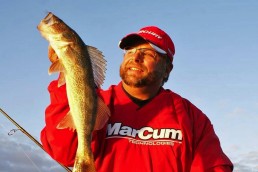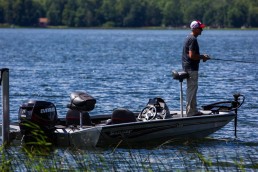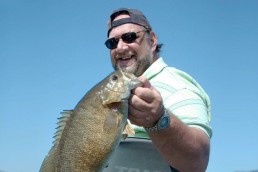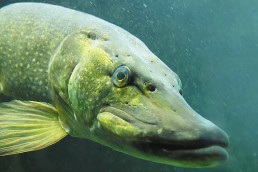Bug ’Eyes: Key on Bug Hatches to Find Feeding Gamefish
SHARE THIS POST
Are huge insect hatches the first thing that comes to mind when you think about fishing in early summer? They should be.
But don’t let a major hatch get you down. Some of the best bites will occur when bugs first start appearing. I’m not just talking about the pesky little mosquitos and black flies that swarm you at the boat launch. I’m focusing on the larger bugs that start out as aquatic insects, such as the mayfly. If you key in on the very spots bug hatches are taking place, you’ll find the feeding gamefish, including the walleyes.
Seek and ye shall find fish
Locating emerging bugs is not difficult; sometimes, I just watch the water’s surface. Often, I’ll have to use my sonar and underwater camera to find insects under the surface. I just have to make sure to look for the smallest signs.
Ponder sitting upon the shore during the early-morning hours, hot coffee in hand, taking in the environment as the mist rises off the flat-calm surface—you almost always see little dimples on the surface, suddenly appearing from nowhere in certain areas of the lake. But that’s not falling rain; those are bugs flying up and off the lake. Mere moments before, they were nymphs waggling their way from the bottom to the surface. But I guarantee you there are more than just insects in the area. There are minnows, young-of the-year fish, and predator fish and even walleyes that high. So, when you see a bug hatch happening, you better grab your rod and reel as the bite’s on.
Sneaking in
When I see the minute rings on the surface over deeper water I’ll set a course for them and prepare to troll. But I don’t run my boat right through the mass of emerging bugs, as that would spook any gamefish and rile the environment enough to stop the hatch all together. Instead, I quietly pull my Lund with the bow-mounted electric trolling motor toward the tiny disturbances in the surface, making sure to stay off to the side of where the hatch is taking place. Then, I pull tiny spinners (‘crawler harnesses) or small crankbaits behind Church Tackle inline planer boards through an area. To stay as stealthy as possible I’ll use Church’s smallest TX-6 boards.
I also like to cast to bug hatches when I see these occurring in the shallows. Again, with only my bow-mounted electric trolling motor to position my boat, I make sure to stay away from the hatching insects, yet get within casting distance.
Look out below!
I find insects when they are not in the process of hatching with my sonar. And when coupled with Navionics mapping, I not only know where the submerged bugs are at the moment, but also can decipher where they may be in other parts of the lake.
Nymphs can look like any number of things on sonar. For example, that surface clutter the sonar is marking high in the water column can be dust and plankton. I guarantee you these are insects mixed in there as well. Sometimes, it may be a strange mass that shows up on the screen. These too are probably bugs. Large, individual aquatic insects will show up too, looking like thin diagonal streaks on the screen. They appear this way as they wiggle their way up off the bottom while a boat is stationary and the sonar’s screen scrolls.
Aquatic insects tend to be in areas of a lake with a soft bottom or within the thermocline over specific water depths. When I mark a mass of bugs on my sonar, I not only pay attention to where they are at in the water column, but also how deep the water is and the type of bottom. More than likely, other places on the lake with comparable characteristics will have the same “buggy” situations happening.
Are you enjoying this post?
You can be among the first to get the latest info on where to go, what to use and how to use it!
Because of the information from a Navionics mapping program I have running in the background of the GPS (via an SD card in the unit’s card reader), I know the exact lay of the underwater land. I can then check out other places of a lake where bugs might be emerging after taking note of the bottom composition, depth and contours.
In shallower water of 15 feet or less, I’ll use an underwater viewing system to spot insects. I’ll check out the aquatic life around weeds, wood and rocks, as well as over mud flats. Aquatic insects are easy to spot as the high-definition picture of underwater cameras nowadays can watch for insects scouring about. This is when I break out the jigging rod.
Matchmaker
When insects are the main forage, walleyes will get real specific as to what size of bait they will hit. Overall, using smaller baits will get bit more than large ones, as the insects are tiny and that’s what the fish are zoning in on. During a hatch, I’ll use small spinners, crankbaits and jigs to best match the forage at hand.
When using spinners, I reduce the size of my Northland Baitfish-Image Colorado blade number 2 and only use a small portion of a live nightcrawler, a small piece of Berkley Gulp or PowerBait Night Crawler on a single hook. These blades have a lot of “bling” from the holographic images. Ones with a gold or a copper hue to them are always a good choice, as they best match the natural color of many nymphs.
When trolling crankbaits, I like to use number 5 Rapala Shallow Shad Rap and a Scatter Rap Shad. If I’m casting, I’ll throw a number 5 Rapala CountDown and Scatter Rap CountDown, the 5 and 7 Original Floaters as well a number 6 Husky Jerk and Scatter Rap Deep Husky Jerk.
I also like to match the color of the forage when fishing in clear water and then go with fluorescent colors when fishing in stained water.
When casting jigs in shallow water, I reduce the size of the head down to a 1/16- or 1/8-ounce Northland Sink’N Jig, and then skewer on a Berkley PowerBait Pro Jig Worm. The color spectrum of these jig-and-plastic combos is endless.
In the end
Do insects drive you buggy during late spring or early summer in June? I hope so. Ignore them, and you’ll be missing out on some of the best fishing of the year. Find them with your naked eye as they fly from a lake’s surface or with your electronics when they’re submersed and reduce the size of your lures and bait. You’ll catch walleyes, for sure.
MWO
SHARE THIS POST
Did you enjoy this post?
You can be among the first to get the latest info on where to go, what to use and how to use it!
Mark Martin
Mark Martin is a professional walleye tournament angler and instructor with the Ice Fishing School/Vacation series. For more information, check out his website at markmartins.net or fishingvacationschool.com.



